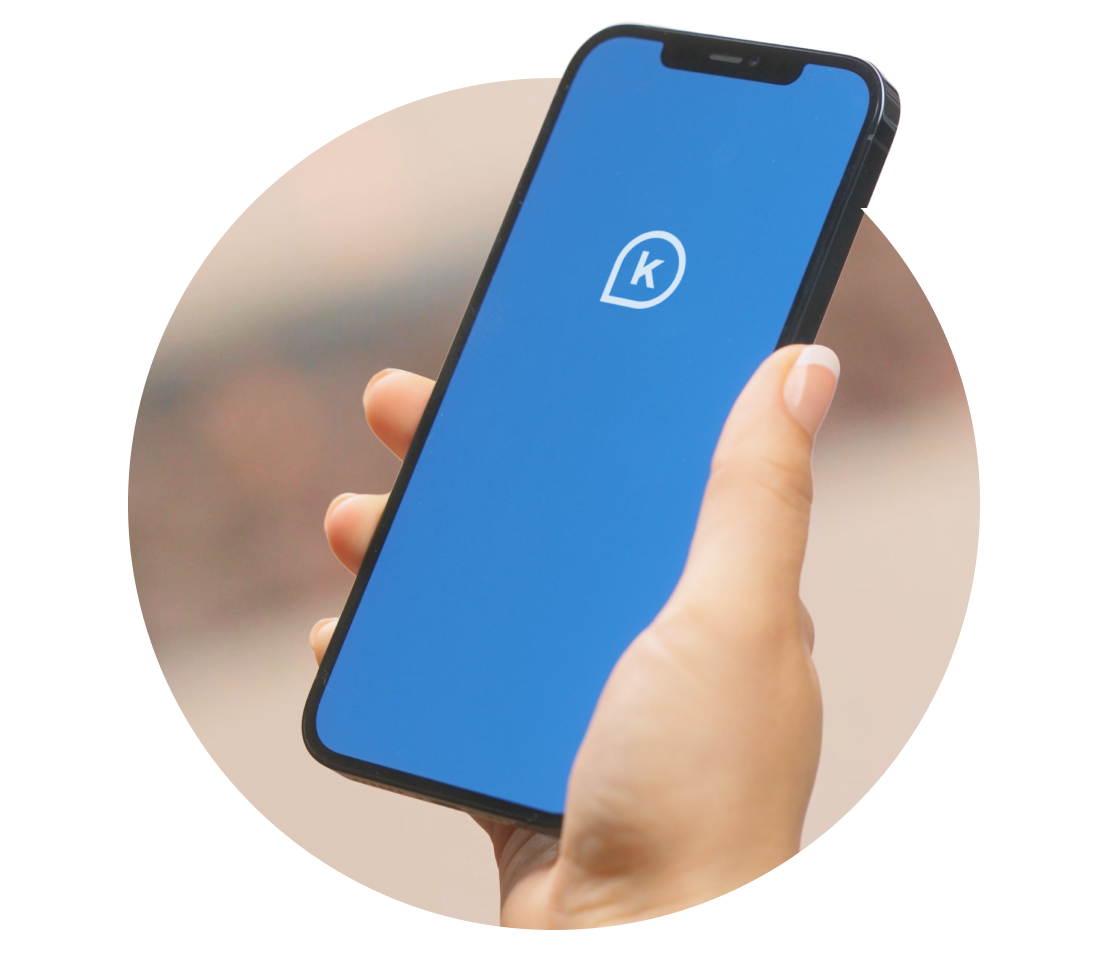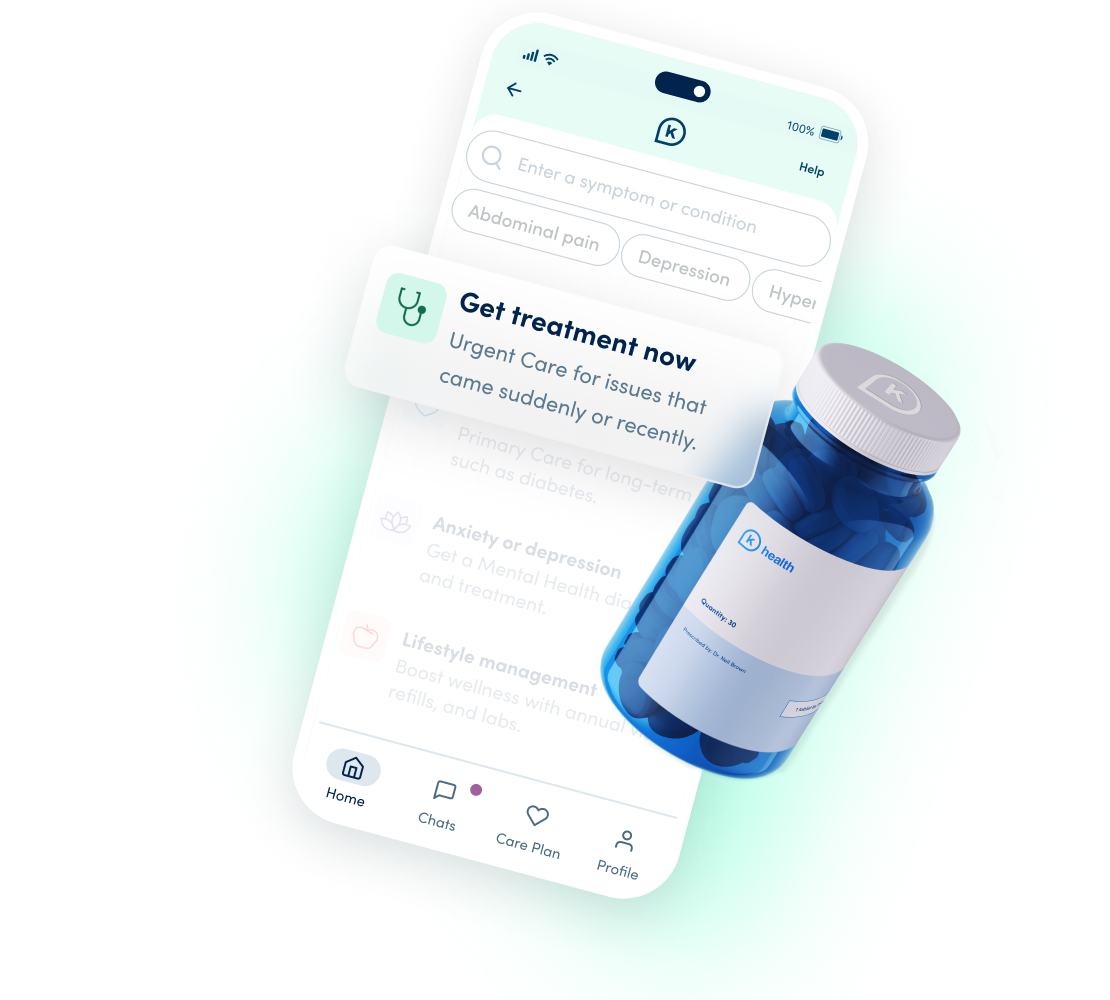TREAT BACK PAIN ONLINE
Text with a medical provider now. Just $49 for your first month of unlimited chats or $73 for a one-time visit. No appointment, no insurance required.
HOW IT WORKS
Feeling better starts here

Get an account
Pay a flat fee, regardless of insurance status. A K Health membership is $49 for your first month, which includes unlimited virtual visits, or a one-time visit is $73.

Chat with a provider
Text with medical providers whenever, from wherever—no appointment needed.* Bypass hold music, travel time, and waiting rooms.

Start feeling better
Your provider shares your treatment plan, and if needed they’ll send a prescription to your local pharmacy. Text us 24/7 if you don’t feel better soon.
Available in all 48 continental US states. Not available in Alaska or Hawaii.
K Health memberships are not insurance and exclude ancillary services (e.g., labs, equipment, cost of medication, etc). See Terms of Service.
Health shouldn’t
require wealth
By treating you remotely and immediately, we save you money.
No surprise fees
No copays
No high deductibles
$73
In-person urgent care
*Based on a survey of out-of-pocket costs at 1,229 urgent care clinics across 43 U.S. states
DON’T REMAIN IN PAIN
GET STARTEDSee a medical provider you trust
-
Our licensed providers were trained at top-tier medical institutions
-
They use advanced health AI technology to provide you with personalized care
-
And they’re available 24/7, just a text away
LEARN MORE
What to Know About Back Pain

What are the different types of back pain?
Back pain is relatively common, and most of us will experience it at some point. There are three main types of back pain:
- Acute: This pain happens suddenly—for instance, an injury or accident may cause it—and it generally lasts a few days or weeks.
- Subacute: This pain can come on suddenly or gradually and usually lasts 4-12 weeks.
- Chronic: This pain is ongoing and typically lasts 12 weeks or more.
You can also experience pain in different parts of your back. In most cases, you’ll have either lower or upper back pain. Lower back pain is more common, and it’s defined as pain anywhere in your back below your ribcage. This part of your back is more prone to pain and injury because it supports most of your upper body’s weight. The pain may feel sharp or like a dull, sore ache.
Upper back pain affects the upper part of the back, also known as the thoracic spine. This pain is often caused by bad posture, overuse, injury, fractures, and more. If you spend a lot of time sitting at a desk and working at a computer, you might experience this type of pain. It’s often accompanied by neck and shoulder pain.
What causes back pain?
There are many causes of back pain, and they range from seemingly benign to severe. While a serious accident can make your back hurt, simply sitting at a desk for too many hours without stretching can also cause pain.
As you get older, your chances of experiencing back pain increase. This means it’s particularly important to understand the causes and risk factors that can contribute to back pain.
Some possible causes include:
- Injuries: It can be surprisingly easy to injure your back. You might experience a strain, fracture, or muscle spasm. Having very tight, tense muscles in your back can also contribute to strains and spasms. Another common cause of back pain is having herniated disks—this happens when there is an injury to one of the smooth, rubbery disks located between each vertebra.
- Structural problems: Abnormalities in your spine’s structure can cause pain, such as herniated disks, degenerative disk disease, fractures, scoliosis, and spinal stenosis (narrowing of the spinal column).
- Inflammation: Several health conditions can cause inflammation in the spine. Examples include ankylosing spondylitis and other types of inflammatory arthritis. Doing too much of the same movement can also put strain on your back and contribute to inflammation. This is especially common in physical jobs, such as construction work, manual labor, and childcare.
- Other health conditions: A variety of other health conditions can cause back pain. Some examples include osteoporosis, bone infections, tumors, fibromyalgia, endometriosis, kidney stones, and pregnancy.
- Lifestyle factors: Your posture, how you sleep, obesity, poor fitness levels, and other factors play a role in how likely you are to experience back pain.
What are the symptoms of back pain?
The main sign of back pain is having pain anywhere in the back. However, it can cause other symptoms like:
- Aching
- Numbness
- Tingling
- Stiffness
- Soreness
- Weakness
Your back pain might come and go, or it might get worse or better at different points in the day. For example, some people find that their back pain is worse when they first wake up in the morning. Be cautious with back pain that includes bowel or bladder retention or incontinence, as this can indicate an emergency neurological condition.
What’s the best treatment for back pain?
Mild to moderate back pain typically gets better with rest, home remedies, and over-the-counter (OTC) pain relievers. If you’re experiencing this type of pain, you can try home treatment methods like:
- OTC medication: Nonsteroidal anti-inflammatory drugs (NSAIDs) such as ibuprofen (Advil) and naproxen (Aleve) can relieve pain.
- Heat: Warm compresses can help tight, sore muscles and may promote healing.
- Cold: If your back is swollen, cold packs can help reduce inflammation and pain.
- Rest: Avoid strenuous activities or movements that aggravate your back. However, avoid staying in bed or sitting still all day—limited amounts of gentle movement can help your back strength and mobility.
If home remedies don’t relieve your pain, it’s time to speak with a healthcare provider. They can recommend the best course of treatment based on the cause of your pain and medical history. For example, they may recommend physical therapy, lifestyle changes, and medications or medical treatments tailored to your condition.
How to prevent back pain?
As we get older, we’re all more likely to experience back pain. However, you can take steps to reduce your risk by staying healthy and active. Get regular exercise and aim to incorporate core and back strengthening exercises. Stretching and yoga can also reduce your risk of pain and injuries.
It’s also important to focus on maintaining good posture. If you spend a lot of time sitting at a desk, invest in a quality chair that has adequate back support and adjustable armrests. A standing desk or frequent standing and movement can help as well.
What pain relievers are best for back pain?
There are several different types of medications that can help with back pain. While some are available OTC, others require a doctor’s prescription.
- OTC pain relievers: You can try acetaminophen (Tylenol), naproxen (Aleve), or ibuprofen (Advil).
- Muscle relaxers: These work by relieving back tension and preventing spasms, but they require a prescription. Examples include cyclobenzaprine (Amrix) and methocarbamol (Robaxin, Robaxin-750).
- Prescription pain relievers: If OTC options don’t help your back pain, your medical provider may prescribe a stronger medication like codeine or tramadol.
- Antidepressants: Certain antidepressant medications may help chronic lower back pain. Some medications your doctor may prescribe include amitriptyline (Elavil) and duloxetine (Cymbalta).
Does stretching help back pain?
Yes, stretching can help back pain. For example, if you have lower back pain caused by muscle tightness, gentle stretching will help to relieve your pain. It’s important to go slowly, stretch gently, and avoid any movements or stretches that are painful. If a stretch or yoga pose makes your pain worse, stop right away.
Can back pain be treated online?
Yes, you can treat back pain online by seeing a healthcare provider virtually. First, they’ll likely ask about your symptoms, how long symptoms have been present, and if you’ve had back pain in the past. They’ll also ask you to describe your pain and when it started. If they are able to determine the most likely cause, they can recommend a course of treatment or refer you to a specialist.
It’s a good idea to make an appointment with a healthcare provider if you’ve experienced:
- Back pain that doesn’t improve
- Severe back pain that impacts your daily life
- Back pain after a significant injury
- Numbness and tingling
- Fever
- Weakness in your legs
- Incontinence
- Unintended weight loss

Frequently asked questions
How do I get my prescription?
If one of our K Health-affiliated clinicians believes it’s medically appropriate, they’ll write a prescription and send it to a local pharmacy of your choice. To get a prescription, you’ll need to submit:
- Your home address
- The address and name of the pharmacy you want the prescription sent to
- A selfie for us to compare to your ID card photo to verify your identify
What’s included in the K Health membership?
Our K Health membership includes nearly everything K Health offers:
- Unlimited text-based visits with licensed medical providers
- 24/7 Urgent Care without an appointment
- Flexible appointments for chronic condition management
- Easy prescription management and renewals
- Treatment for anxiety and depression, including medication shipped to your door (medication cost not included)
- As always, no insurance needed, all on your own schedule
*24/7 Urgent Care is available in 48 states of the US. Not available in Alaska or Hawaii.
K Health memberships are not insurance and do not include any ancillary services, (e.g.) laboratory tests, durable medical equipment, appointments with other providers or specialists that we may refer you to, emergency or in-person urgent care facility visits; cost of medication and other referrals. Medical care is provided by K Health’s affiliated professional corporations. See Terms of Service.
How much does K Health cost?
If you want to chat with a medical provider, you can purchase a membership for just $49 for the first month, which gives you access to:
- Unlimited text-based visits with licensed medical providers
- 24/7 Urgent Care without an appointment
- Flexible appointments for chronic condition management
- Easy prescription management and renewals
- Treatment for anxiety and depression, including medication shipped to your door (medication cost not included)
- As always, no insurance needed, all on your own schedule
After your first month, you’ll automatically be enrolled in a quarterly plan (which is $147 each time). You’re free to cancel until 1 day before your membership renewal date.
If you prefer, you can instead pay for a one-time virtual visit, which costs $73 and includes 1 week of follow-up chats. You can also download the K Health app and use our smart Symptom Checker for free.
*24/7 Urgent Care is available in 48 states of the US. Not available in Alaska or Hawaii.
K Health memberships are not insurance and do not include any ancillary services, (e.g.) laboratory tests, durable medical equipment, appointments with other providers or specialists that we may refer you to, emergency or in-person urgent care facility visits; cost of medication and other referrals. Medical care is provided by K Health’s affiliated professional corporations. See Terms of Service.
Do you need insurance to use K Health?
Nope!
We’ve created efficient ways to bring the cost of healthcare way down and make quality care accessible to everyone, without needing to use health insurance.
You can sign up for our K Health membership which includes access to our Primary Care program, 24/7 Urgent Care visits, treatment for anxiety and depression, and more,* or you can pay for a one-time virtual visit. Plus, our Symptom Checker is always free to use.
Learn more about our approach to pricing
*24/7 Urgent Care is available in 48 states of the US. Not available in Alaska or Hawaii.
K Health memberships are not insurance and do not include any ancillary services, (e.g.) laboratory tests, durable medical equipment, appointments with other providers or specialists that we may refer you to, emergency or in-person urgent care facility visits; cost of medication and other referrals. Medical care is provided by K Health’s affiliated professional corporations.
See Terms of Service.
Can I use my insurance to pay for K Health?
With the exception of certain Surest and Elevance Health plans, we don’t accept insurance to pay for K Health memberships, one-time Urgent Care virtual visits, or mail-order medication, but we keep our prices low to keep medical care accessible to everyone. In many cases, our prices are lower than your insurance copay would have been!
If your medical provider prescribes you medication to pick up at your local pharmacy or orders bloodwork to a lab of your choice, you can use your insurance at those locations.
Are there any conditions that K Health doesn’t treat?
K Health-affiliated medical providers can diagnose and treat most things you might see an in-person primary care doctor for. However, there are sometimes instances when we recommend you see a doctor in person.
For example, ear infections and strep throat are two common conditions that require an in-person consultation for diagnosis. However, K Health-affiliated providers can help assess severity and provide guidance on what to do next.
We also don’t treat anyone who:
- is under 18 years old
- lives in Hawaii or Alaska
- has a medical condition that requires a specialist (on a case by case basis)
- is currently pregnant
- is currently being treated for cancer with chemotherapy or radiotherapy
- has an autoimmune disease
- is currently on immunosuppressants
- is diagnosed with AIDS
- is currently in hospice care
- has a history of organ transplant
- is dependent on oxygen
- has significant liver, kidney, or other organ failure
- is seeking medical management related to worker’s comp or injury litigation
We don’t prescribe controlled substances, and we cannot prescribe other high-risk medications that are subject to abuse. Learn more in our Medical Policies.
*24/7 Urgent Care is available in all 48 continental US states. Not available in Alaska or Hawaii. K Health memberships are not insurance and exclude ancillary services (e.g., referrals, labs, equipment, cost of medication, etc). Medical care is provided by K Health’s affiliated professional corporations. See Terms of Service.
Recommended content
All articles














